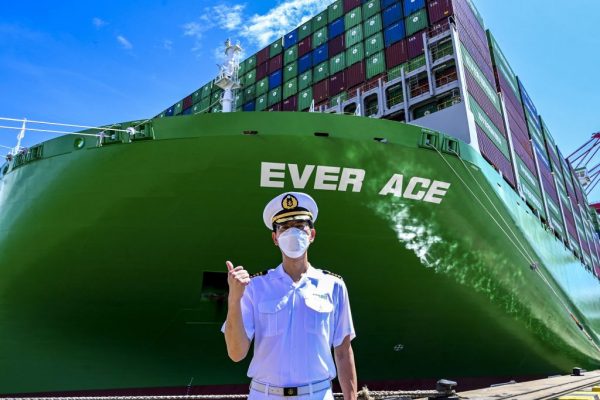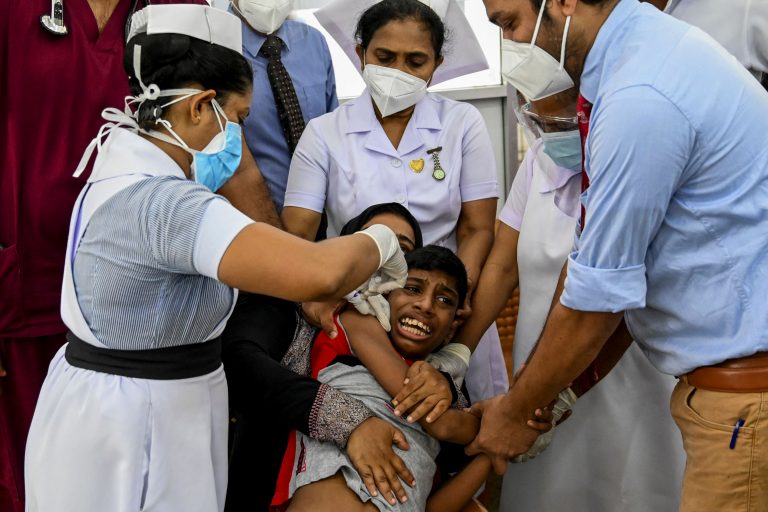Sri Lanka lifted its COVID-19 lockdown on Oct. 1 even as, according to officials and traders, more than 800 containers carrying essential items were held up in the country’s main port due to a lack of U.S. dollars for purchasing them. A shortage of essential items such as milk powder, sugar and cooking gas is causing queues outside of stores.
As Sri Lanka resisted a COVID-19 surge caused by the Delta variant, a shutdown of the country was imposed on Aug. 20 and extended three times. Prior to the Aug. 20 measures, Sri Lanka had been resisting a total shutdown, citing economic factors.
According to a report in the New Indian Express, seven days before the Aug. 20 lockdowns were imposed, Sri Lanka’s National COVID-19 Prevention Centre said that after Sept. 15, inter-provincial travel and moving about in public spaces would be allowed only for those with vaccination cards. It has not been confirmed if the lifting of the lockdown measures restores freedom of movement to the 50 percent of the population that remains unvaccinated, or if the recently lifted lockdown applied to the vaccinated as well.
The army was placed in charge of preventing COVID-19 in Sri Lanka; Army Commander General Shavendra Silva heads the country’s army as well as the National Operation Center for Prevention of COVID-19 Outbreak (NOCPCO).
Spread could have been prevented
According to commentator, Sunil J. Wimalawansa, a medical doctor and opinion writer who obtained his degree at a prominent Sri Lankan university, spreads within a community could have been “prevented through geographically limited lockdowns not exceeding two weeks while supplying essentials to the local community.”
Success
You are now signed up for our newsletter
Success
Check your email to complete sign up
Wimalawansa also recommended at-home quarantines, stating “There was no rationale for military-style, forced quarantining of people. Those exposed to a person infected with COVID-19 and PCR positive asymptomatic persons could have better and cost-effectively managed in their homes, with oversights from the medical officer of health and public health inspectors.”
Wimalawansa further stated that “Shutting down entire districts or the country was a colossal mistake,” explaining that the livelihoods of up to two thirds of the country’s adult population may have been affected.
The country had embarked on a well-documented vaccine program in late January of this year. After challenges in procurement and controversies over approval at the outset, Sri Lanka is now considered one of the most heavily-vaccinated countries in the world, with shots for children as young as 12 and a claim of two doses of vaccine administered for 50 percent of the population.
For children, it was approved to use a vaccine that was not easy for the island nation to come by: four million doses of Pfizer-BioNtech. Sri Lankan Minister of Health Keheliya ordered health workers to stop administering this vaccine to anyone between 18 and 30 years of age and to preserve remaining Pfizer doses for the children. He indicated that those between 18 and 30 could take a Chinese-made vaccine.
New Delhi-based news organization WION reported in June that, according to Johns Hopkins data, only 3.98 percent of Sri Lanka’s population had been fully vaccinated.
Vaccine surge fueled by Chinese vaccines
Of concern, the huge subsequent vaccine surge seems to have been fueled largely by Chinese vaccines, Sinopharm and Sinovac. As CNN phrased the situation in June, with these vaccines and after less than stellar results in Mongolia, Indonesia, and Seychelles, “whether the two WHO-approved Chinese vaccines have failed depends on the metrics for success,” and, just for good measure, the news outlet issued a similar statement to that effect that the situation is “not as bad as it sounds.”
Whether it is as bad as it sounds or not, Sri Lanka may eventually be another proving ground for the issue due to the proportion of vaccinations coming from China.
According to WION, Sri Lankan President Gotobaya Rajapaksa stated the following on June 23:
“At present, the vaccination drive is being carried out successfully in all provinces of the country. In July, we expect to receive 4 million doses of Sinopharm vaccine and 2.5 million doses of Sinovac. Arrangements have also been made to obtain 2 million Sputnik V doses. In addition, 5 million doses of Sinopharm vaccine, 2.5 million doses of Sinovac and 2 million doses of Sputnik V are expected in August. By getting 3 million more Sinopharm vaccine doses in September, we could vaccinate 13 million people by the end of September this year. Accordingly, we can vaccinate almost everyone over the age of 30 by that time. This is a very satisfactory situation.”
In early 2021, Sri Lanka received a donation of Sinopharm vaccines from China and “several medical experts raised concerns over incomplete documentation and certain technical issues,” resulting in the firing of some medical experts.To quote the Daily Mirror, this spring the Committee on Public Accounts (COPA) Chairman Prof. Tissa Vitharana revealed that he was “unaware of the circumstances that prompted the sacking of medical experts who opposed the approval of the Sinopharm vaccine.”

Sri Lanka’s reliance on China’s vaccines is telling, given the nation’s proximity to India, which has been attempting to provide vaccines to its neighbors in the region. India did attempt to provide over one million AstraZeneca vaccines, but was held up in projected donations due to a surge in India. Sri Lanka’s reliance on China in the past has been associated with debt-burden schemes and sphere-of-influence diplomacy.
Certain concerns related to the science behind vaccine implementation in Sri Lanka have been cited by experts. One major concern was raised by Ravi Kumudesh, who commented that vaccines should not be mixed but that the government did not make plans to administer double doses, which are particularly important to the proper functioning of the vaccines, with some even saying that not administering the second dose properly can lead to mutations and resistance.
Second dose of vaccine in question
Kumudesh stated, “It has always been said that when giving a first dose of a vaccine, the second dose also needs to be considered. Therefore if we received one million vaccines, only 500,000 should be given to the public. The entire world is running out of vaccines, even developed countries. There’s a speed at which vaccines are being developed. We have so far given around 900,000 vaccines out of the total and only around 200,000 are remaining. The second dose is particularly important during the formation of antibodies.”
Does this mean that in the spring of 2021, 700,000 people in Sri Lanka did not properly receive their second dose of vaccine?
Kumudesh fretted, “Therefore this is a deliberate mistake done by the government. What needs to be done is to get down the remaining doses of vaccines and continue the programme.”
The Indian Ocean island country, with a population of 22 million, was the first country to report a ‘triple’ Delta mutation.
The first Delta case in Sri Lanka was in the capital of Colombo, the most populous city with more than 5.6 million inhabitants, which is also the Sri Lankan city where the country’s first immunizations occurred. It was not known if the afflicted patient 0 for the variant was immunized. The mutations are not considered a new strain, and they are thought to be guarded against, if not prevented, by the same vaccines. According to Republic World, the country has detected a total of four Delta variant mutations to date, with two of them being exclusive to Sri Lanka and one being found in only Sri Lanka and Malaysia.
Johns Hopkins confirms the present full vaccination rate, listing 12,255,004 people as having been fully vaccinated. According to the COVID-19 Situation Report from the Government of Sri Lanka, the country presently has had 525,663 confirmed cases of Covid-19, with 13,296 total deaths, 479,629 recoveries, and 32,738 active cases. Data on vaccine-breakthrough cases has not been obtained for the country.
Sri Lanka’s reopening is not a full easing of imposed restrictions. Travel is allowed for work and for the purchase of essential items, and according to General Silva’s NOCPCO update, “Inter provincial public transport would continue but no train services are to be operated until further notice.” Buses began running and street vendors opened their stalls while push carts full of produce for sale returned to the streets of the capital. A night-time curfew is imposed from 10 p.m. until 4 a.m.

















